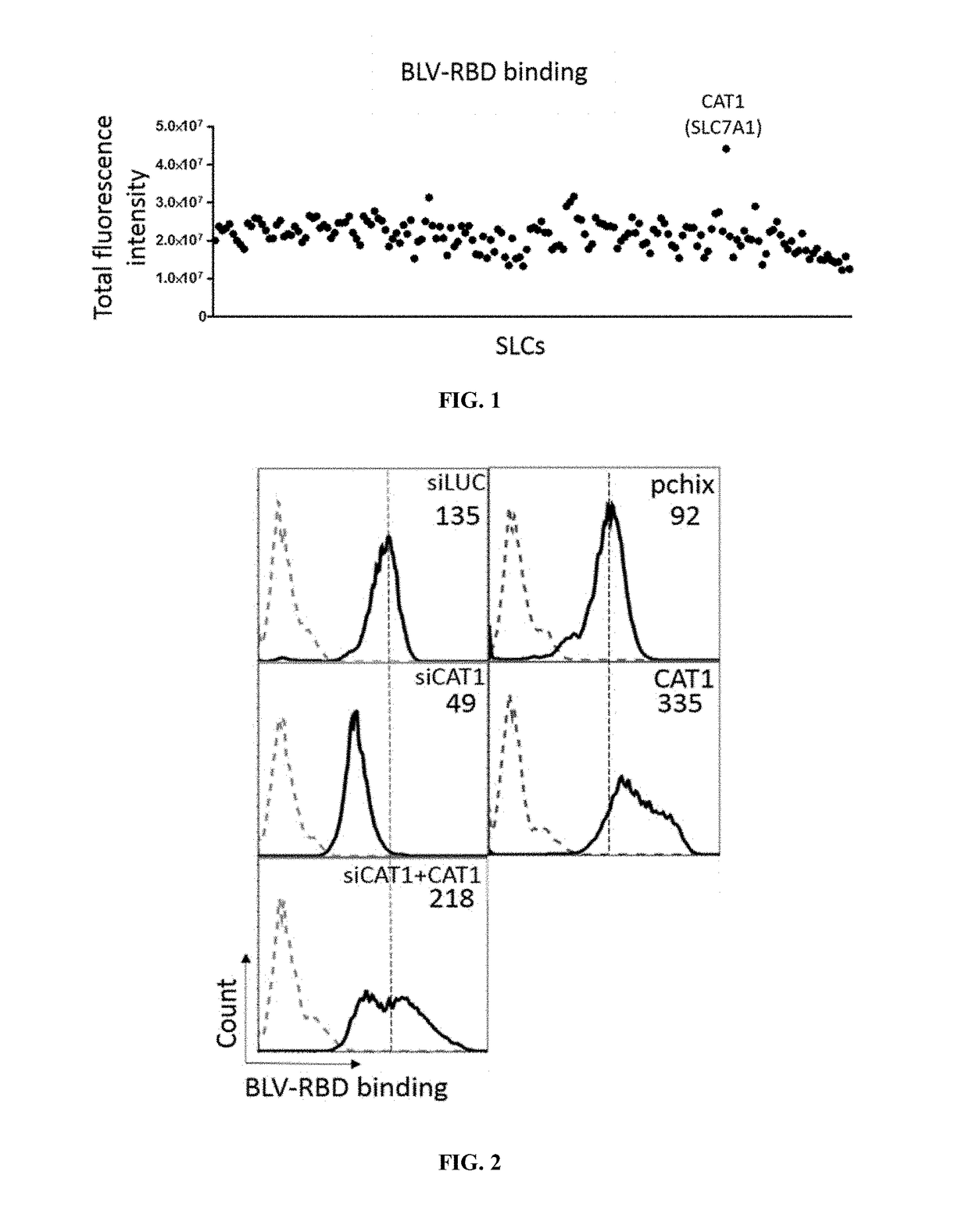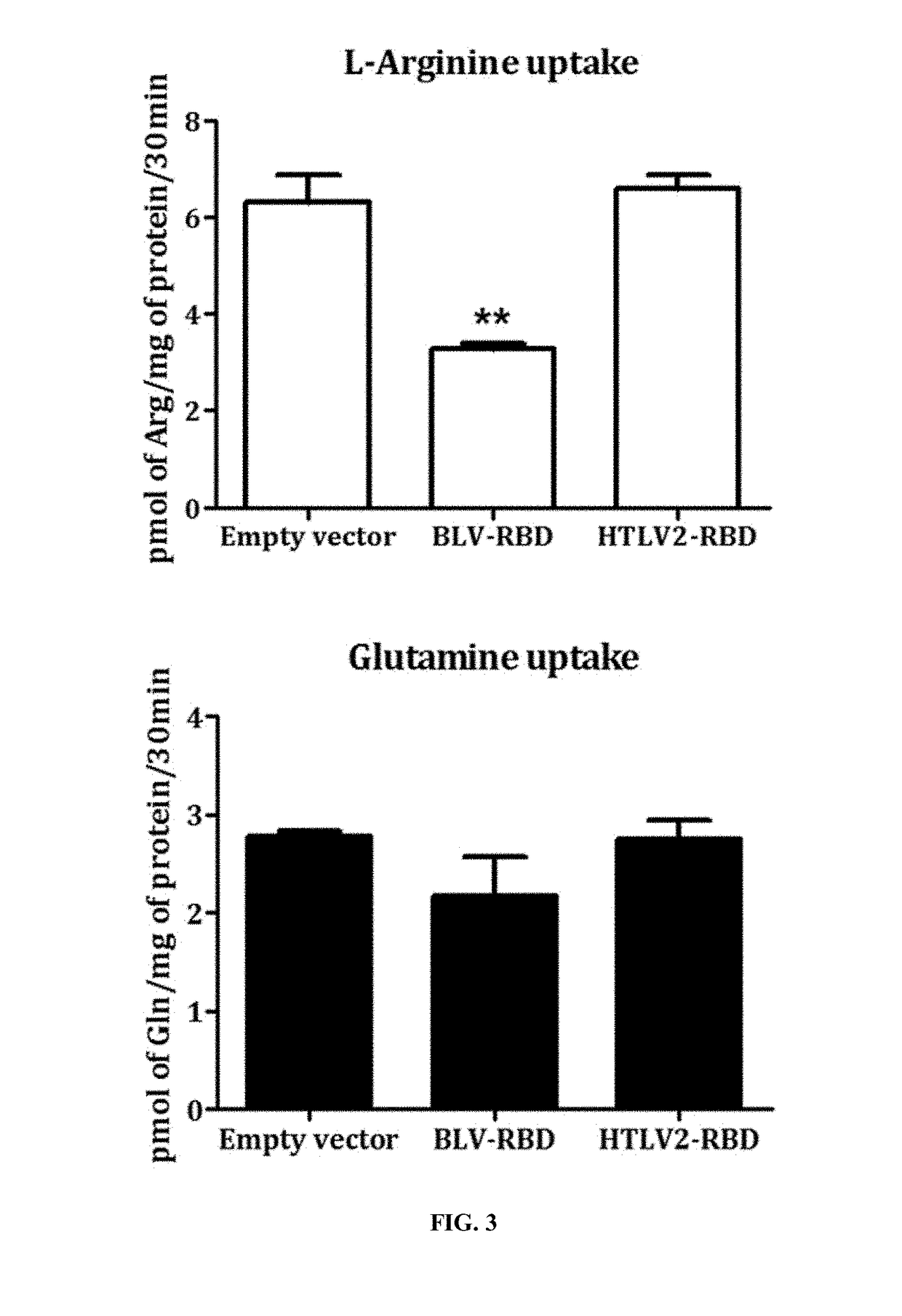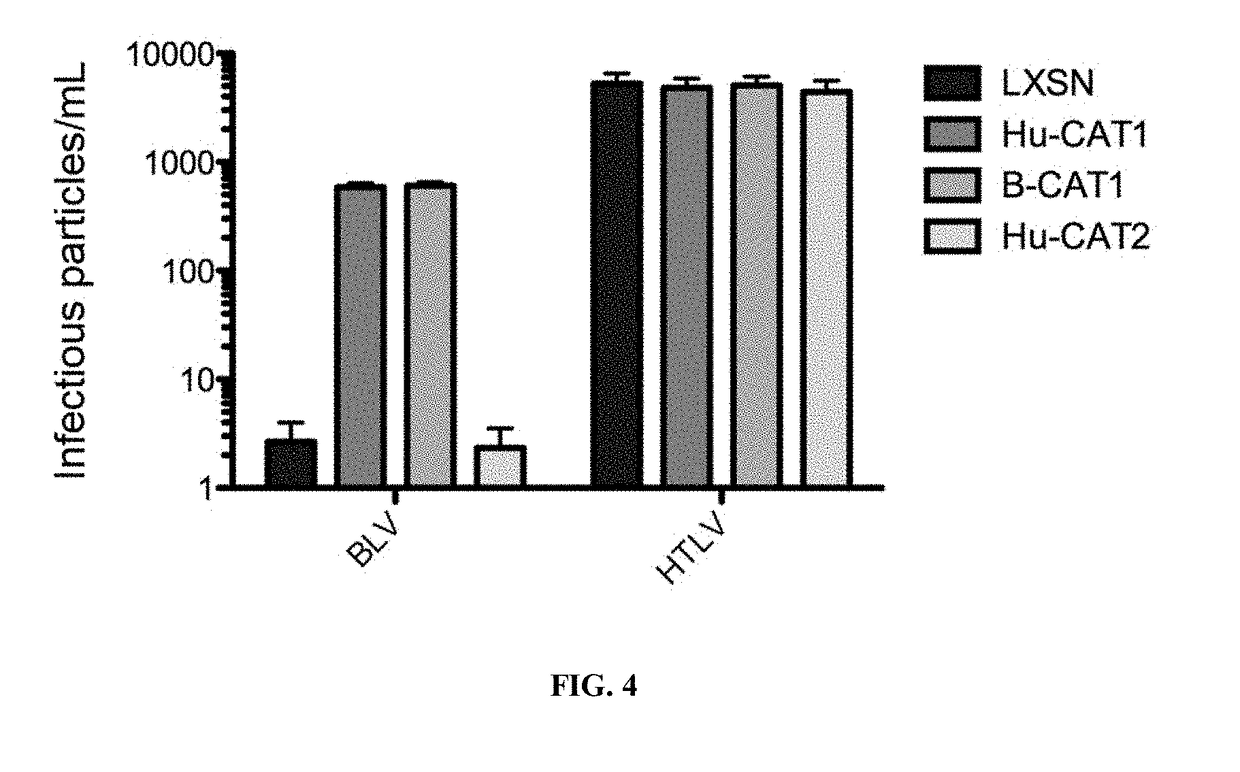Use of receptor-binding domain derived from bovine leukemia virus for the diagnosis or treatment of cationic l-amino acid transporter-related diseases
a technology of cationic lamino acid transporter and receptor-binding domain, which is applied in the direction of metabolism disorder, peptide/protein ingredient, instruments, etc., can solve the problems of inability to accurately target other mammalian cat1 ligands, and the resistance to these treatments appears besides undesirable side effects
- Summary
- Abstract
- Description
- Claims
- Application Information
AI Technical Summary
Benefits of technology
Problems solved by technology
Method used
Image
Examples
example 1
Binding of BLV.RBD to CAT1
[0302]Materials and Methods
[0303]Cell Culture and Transfection
[0304]All cell lines were maintained in DMEM culture medium (Dulbecco's Modified Eagle Medium) supplied by Life Technologies (ref: 11965-092) with 10% decomplemented fetal bovine serum (PAN Biotech); non-essential amino acids (11140-035, Life Technologies); glutamine (25030-081 Life Technologies) and antibiotics (penicillin and streptomycin). All were incubated at 37° C. in a 5% CO2-95% air atmosphere. 20 000 QT6 cells were seeded in a 96-well plate. Cells were transfected with 100 ng of DNA using JetPrime transfection protocol. Conditions for binding with BLV.RBD were optimized for automated conditions.
[0305]Staining for Tecan Robot and Cellomics Microscope
[0306]Staining was performed 48 hours post-transfection, using a BLV.RBD-mFc ligand (SEQ ID NO: 27). For this purpose, RBD ligands were tested at a 1 / 10 (v:v) dilution and the anti-mouse IgG1 bound to Alexa Fluor® 488 was used (1 to 500 diluti...
example 2
nduced Inhibition of Arginine Uptake in Cells
[0313]Materials and Methods
[0314]Uptake Assays
[0315]3.5×105 HEK293T cells per well were seeded in a 6-well plate coated with poly-D lysine. The following day, the cells were transfected using calcium phosphate with the vectors: pCSI rabbit Fc (rFc), pCSI BLV.RBD rFc (SEQ ID NO: 12) et pCSI HTLV2.RBD rFc (SEQ ID NO: 7). 16 hours post-transfection, the cell medium was changed and 24 hours later, the cells were seeded in 24-well plates (5×104 cells / well) for the uptake of L-arginine or L-glutamine radiolabeled or in 6-well plates (3×105 cells / well) to lyse the cells and verify the expression of RBD by immunoblotting.
[0316]For uptake, cells were incubated in a volume of 250 μL for 30 minutes at 37° C. with 5 μCi / mL of L-arginine monohydrochloride [2,3,4-3H] (NET1123250UC, Perkin Elmer) or L-glutamine [3,4-3H (N)] (NET551001MC Perkin Elmer) diluted in DMEM classic. After two washes with cold PBS, cells were lysed with 500 μL Triton X-100 1% an...
example 3
itro of the Effect of BLV.RBD on a BLV Infection
[0323]Materials and Methods
[0324]Materials
[0325]Infection of A23 cell line stably expressing CAT1 from different mammal species (A23-LXSN: empty vector; A23-CAT1 human; A23-Cat1 cattle; A23-mouse Cat1 mouse and A23-hamster Cat1).
[0326]Culture medium: HEK293 cells are grown up in DMEM with 10% FBS, L-glutamine, nonessential amino acids and antibiotics (Penicillin streptomycin). The producing cells (HEK293) and the infected A23 cells will encode for GFP.
[0327]Method
[0328]At Day 0 (D0): seed 4 Petri dishes (10 cm diameter) with HEK293 cells (ATCC) 3×106 cells / dish.
[0329]At D1 (evening): transfection of HEK293 in order to produce viral pseudotypes coding for the following envelopes (HTLV2; BLV; Vesicular stomatitis Indiana virus (VSV) or without envelope). Co-transfection with the following vectors:[0330]LNCG (code for GFP): 10 μg,[0331]BEB.GP57 (gag-pol): 5 μg,[0332]Envelope glycoprotein: 5 μg.
PUM
| Property | Measurement | Unit |
|---|---|---|
| Level | aaaaa | aaaaa |
Abstract
Description
Claims
Application Information
 Login to View More
Login to View More - R&D
- Intellectual Property
- Life Sciences
- Materials
- Tech Scout
- Unparalleled Data Quality
- Higher Quality Content
- 60% Fewer Hallucinations
Browse by: Latest US Patents, China's latest patents, Technical Efficacy Thesaurus, Application Domain, Technology Topic, Popular Technical Reports.
© 2025 PatSnap. All rights reserved.Legal|Privacy policy|Modern Slavery Act Transparency Statement|Sitemap|About US| Contact US: help@patsnap.com



